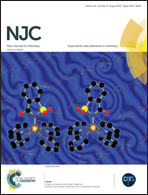HOMO energy level regulation of novel conjugated copolymers for polymer solar cells
Abstract
Three novel donor–acceptor (D–A) conjugated copolymers for polymer solar cells (PSC) are presented in this work. By Stille coupling polymerization, indacenodithiophene (IDT), as an electron-rich unit, was conjugated with an electron-deficient unit of isoindigo (IID), which led to a novel alternative copolymer IDT–IID (P1). Two electron-deficient units, 2,1,3-benzooxadiazole (BO) and diketopyrrolopyrrole (DPP), were respectively introduced in the polymerization of P1, and two novel IDT-based D–A1–D–A2 random copolymers IDT–IID–IDT–BO (P2) and IDT–IID–IDT–DPP (P3) were obtained. Thermal property tests indicated that these molecules possess relative stability and are suitable for solar cell applications. Optical and electrochemical measurements revealed that the HOMO energy levels of the three copolymers were −5.46 eV, −5.34 eV, and −5.23 eV respectively, while the LUMO levels were almost kept stable around −3.56 eV and the low band gap levels led to complete absorption in the visible region. The PSCs based on these copolymers were fabricated with the structure of ITO/PEDOT : PSS/polymer : PC71BM/Ca/Al, and the photovoltaic properties disclosed the relatively high values of open circuit voltage (Voc) due to the low-lying HOMO energy levels of each copolymer. Hole mobility and atomic force microscopy (AFM) study were applied to improve the PSCs performance. Our work provides an efficient method to regulate the HOMO energy levels which will be beneficial for PSCs by synthesizing different conjugated copolymers.



 Please wait while we load your content...
Please wait while we load your content...